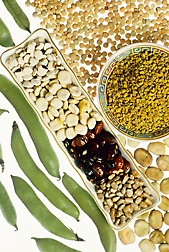This page has been archived and is being provided for reference purposes only. The page is no longer being updated, and therefore, links on the page may be invalid.
| Read the magazine story to find out more. |
|
|
|
|
Updated Plant Genebank System Available Soon
By Sandra AvantOctober 26, 2011
A free, user-friendly online database system for managing the world's plant genebanks will be launched this year, thanks to a partnership between the U.S. Department of Agriculture (USDA) and the Consultative Group on International Agricultural Research (CGIAR).
The international project involves updating a germplasm management system called GRIN, originally developed by USDA's Agricultural Research Service (ARS). The updated system, called GRIN-Global, will be initiated at CGIAR centers by December 2011, and in the United States in 2012.
ARS uses GRIN—the Germplasm Resources Information Network—to manage agricultural data on plant genetic resources at various genebank sites.
Using GRIN-Global, other nations will have the ability to document their plant germplasm and deliver that information worldwide, according to Peter Cyr, information technology specialist and project leader at the ARS North Central Regional Plant Introduction Station in Ames, Iowa. Each genebank will have its own local version of the GRIN-Global software, which is capable of supporting different languages.
Curators can customize the system to fit their specific needs and keep track of genetic material origins, traits and properties. They can maintain a more accurate inventory status, noting which seeds, plants and tissues are available and how much. In addition, GRIN-Global will make it possible to keep records of requests for seed and plant material.
Public researchers also will have access to germplasm information and material in the system. Scientists, educators and other germplasm users will be better informed about material in genebanks and find it easier to choose exactly the samples they need.
ARS is USDA's principal intramural scientific research agency. The development of GRIN-Global supports the USDA priority of promoting international food security.

